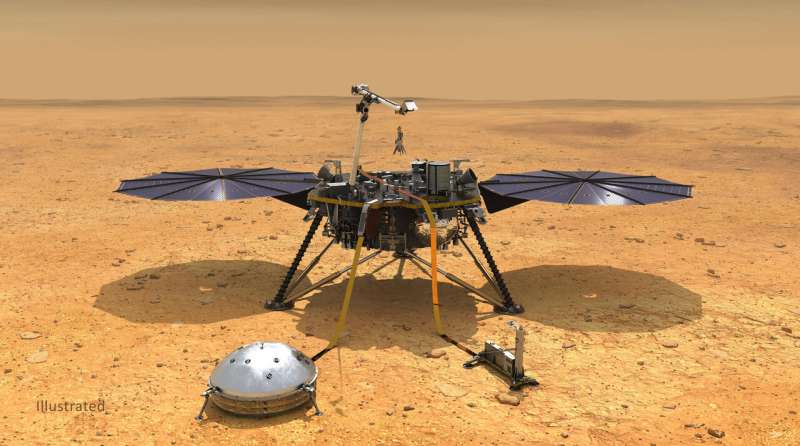Additionally, InSight's team chose a landing site in Elysium Planitia, a windswept plain on the Red Planet's equator that receives lots of sunlight. It was hoped that passing dust devils might clean off the panels, which happened many times with Spirit and Opportunity, allowing them to last years past their design lifetime.
But despite InSight detecting hundreds of passing dust devils, none has been close enough to clean off those dinner-table-size panels since they unfurled on Mars in November 2018. Today, InSight's solar arrays are producing just 27% of their dust-free capacity. That power has to be shared between science instruments, a robotic arm, the spacecraft's radio, and a variety of heaters that keep everything in working order despite subfreezing temperatures. Since the windiest season of the Martian year has just ended, the team isn't counting on a cleaning event in the coming months.
Mars is currently moving toward what's called aphelion, the point in its orbit when it's farthest away from the Sun. That means the already-weak sunlight on the Martian surface is growing even fainter, reducing power when InSight most needs its heaters to stay warm. Mars will start approaching the Sun again in July 2021, after which the team will begin to resume full science operations.
"The amount of power available over the next few months will really be driven by the weather," said InSight's project manager, Chuck Scott of NASA's Jet Propulsion Laboratory in Southern California. "As part of our extended-mission planning, we developed an operations strategy to keep InSight safe through the winter so that we can resume science operations as solar intensity increases." JPL leads the InSight mission, though the spacecraft and its solar panels were built by Lockheed Martin Space of Denver, Colorado.
Over the coming weeks and months, InSight scientists will be carefully selecting which instruments need to be switched off each day to preserve power for heaters and energy-intensive activities like radio communication. InSight's weather sensors are likely to remain off much of the time (resulting in infrequent updates to the mission's weather page), and all the instruments will have to be powered off for some period around aphelion.
Currently, power levels look strong enough to take the lander through the winter. But solar power generation on Mars is always a little uncertain. The Opportunity rover was forced to shut down after a series of dust storms darkened the Martian sky in 2019, and Spirit did not survive the Martian winter in 2010. If InSight were to run out of power due to a sudden dust storm, it is designed to be able to reboot itself when the sunlight returns if its electronics survived the extreme cold.
Later this week, InSight will be commanded to extend its robotic arm over the panels so a camera can take close-up images of the dust coating. Then the team will pulse the motors that unfurled each panel after landing to try to can disturb the dust and see if the wind blows it away. The team considers this to be a long shot but worth the effort.
"The InSight team has put together a strong plan to safely navigate through winter and emerge on the other side ready to complete our extended science mission through 2022," said Bruce Banerdt of JPL, InSight's principal investigator. "We've got a great vehicle and a top-notch team; I'm looking forward to many more new discoveries from InSight in the future."
Explore further



